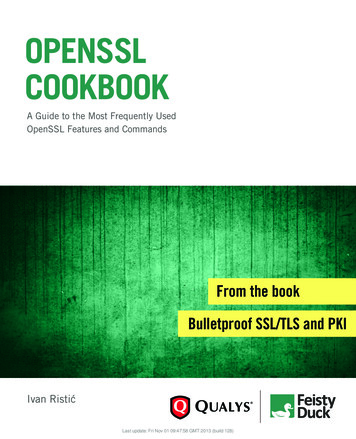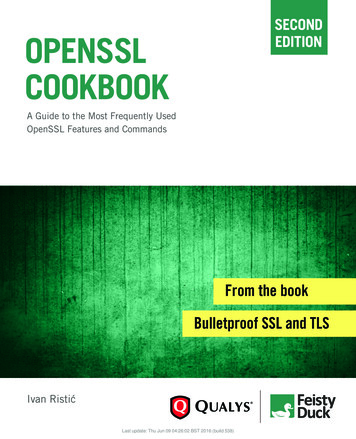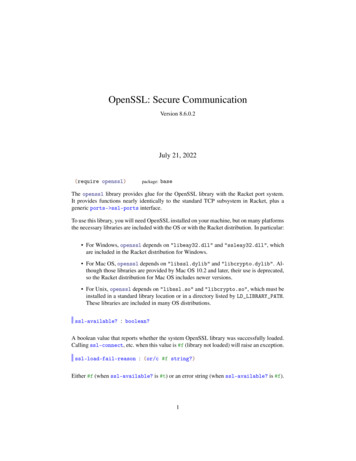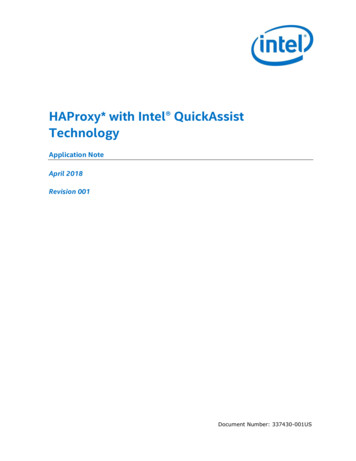
Transcription
OPENSSLCOOKBOOKA Guide to the Most Frequently UsedOpenSSL Features and CommandsFrom the bookBulletproof SSL/TLS and PKIIvan RistićLast update: Fri Nov 01 09:47:58 GMT 2013 (build 128)
The complete guide to securely using SSL/TLSand PKI in infrastructure deployment andweb application developmentBULLETPROOFSSL/TLS AND PKIThe Complete Guide to Securely Using SSL/TLS and PKI inInfrastructure Deployment and Web Application DevelopmentFree edition: Getting StartedIvan Ristićfff UTXbchSdRZ R \FINE TECHNOLOGY BOOKSPersonal copy of Stanley Laurel neolinux33@gmail.com
OpenSSL CookbookIvan RistićPersonal copy of Stanley Laurel neolinux33@gmail.com
OpenSSL Cookbookby Ivan RistićVersion 1.1 build 127, published in October 2013.Copyright 2013 Feisty Duck Limited. All rights reserved.First published in May 2013.ISBN: 978-1907117053Feisty Duck ress:6 Acantha CourtMontpelier RoadLondon W5 2QPUnited KingdomProduction editor: Jelena Girić-RistićCopyeditors: Melinda Rankin, Nancy Wolfe KotaryAll rights reserved. No part of this publication may be reproduced, stored in a retrieval system, or transmitted, in any form orby any means, without the prior permission in writing of the publisher.The author and publisher have taken care in preparation of this book, but make no expressed or implied warranty of any kind andassume no responsibility for errors or omissions. No liability is assumed for incidental or consequential damages in connectionwith or arising out of the use of the information or programs contained herein.Feisty Duck DigitalBook Distributionwww.feistyduck.comPersonal copy of Stanley Laurel neolinux33@gmail.com
Table of ContentsPreface . . . . . . . . . . . . . . . . . . . . . . . . . . . . . . . . . . . . . . . . . . . . . . . . . . . . . . . . . . . . . . . . . . . . . . . . . . . . . . . . . . . . . . . . . . . vFeedbackviAbout Bulletproof SSL/TLS and PKIviAbout the Authorvi1. OpenSSL Cookbook . . . . . . . . . . . . . . . . . . . . . . . . . . . . . . . . . . . . . . . . . . . . . . . . . . . . . . . . . . . . . . . . . . . . . . . . . . . . . . 1Getting Started2Determine OpenSSL Version and Configuration2Building OpenSSL3Examine Available Commands4Building a Trust Store5Key and Certificate Management7Key Generation7Creating Certificate Signing Requests11Creating CSRs from Existing Certificates13Unattended CSR Generation13Signing Your Own Certificates13Creating Certificates Valid for Multiple Hostnames14Examining Certificates15Key and Certificate Conversion18Configuration20Cipher Suite Selection21Performance31A. SSL/TLS Deployment Best Practices . . . . . . . . . . . . . . . . . . . . . . . . . . . . . . . . . . . . . . . . . . . . . . . . . . . . . . . . . . . . . . 35Introduction351. Private Key and Certificate361.1. Use 2048-bit Private Keys361.2. Protect Private Keys361.3. Ensure Sufficient Hostname Coverage361.4. Obtain Certificates from a Reliable CA37iiiPersonal copy of Stanley Laurel neolinux33@gmail.com
2. Configuration2.1. Deploy with Complete and Valid Certificate Chains2.2. Use Only Secure Protocols2.3. Use Only Secure Cipher Suites2.4. Control Cipher Suite Selection2.5. Support Forward Secrecy2.6. Disable Client-Initiated Renegotiation2.7. Mitigate Known Problems3. Performance3.1. Do Not Use Too-Strong Private Keys3.2. Ensure That Session Resumption Works Correctly3.3. Use Persistent Connections (HTTP)3.4. Enable Caching of Public Resources (HTTP)4. Application Design (HTTP)4.1. Encrypt 100% of Your Web Site4.2. Avoid Mixed Content4.3. Understand and Acknowledge Third-Party Trust4.4. Secure Cookies4.5. Deploy HTTP Strict Transport Security4.6. Disable Caching of Sensitive Content4.7. Ensure That There Are No Other Vulnerabilities5. Validation6. Advanced TopicsChangesVersion 1.3 (17 September 2013)AcknowledgmentsAbout SSL LabsAbout QualysB. Changes . . . . . . . . . . . . . . . . . . . . . . . . . . . . . . . . . . . . . . . . . . . . . . . . . . . . . . . . . . . . . . . . . . . . . . . . . . . . . . . . . . . . . .v1.0 (May 2013)v1.1 (October 2013)ivPersonal copy of Stanley Laurel neolinux33@gmail.com 464747494949
PrefaceFor all its warts, OpenSSL is one of the most successful and most important open sourceprojects. It’s successful because it’s so widely used; it’s important because the security of largeparts of the Internet infrastructure relies on it. The project consists of a high-performanceimplementation of key cryptographic algorithms, a complete SSL/TLS and PKI stack, and acommand-line toolkit. I think it’s safe to say that if your job has something to do with security,web development, or system administration, you can’t avoid having to deal with OpenSSL onat least some level.This book is intended primarily for OpenSSL users who need to perform routine tasks of keyand certificate generation and configure programs that rely on OpenSSL for SSL/TLS functionality. The majority of the Internet is powered by open source products, and virtually allof those projects rely on OpenSSL. Apache httpd has long been a favorite, but it’s now beingpursued by nginx, which is increasingly gaining in popularity. And, even in the Java camp,Apache Tomcat performs better when coupled with OpenSSL, replacing the native Java implementation of SSL/TLS.This book is—at least at the moment—built around a chapter from my third book, Bulletproof SSL/TLS and PKI. I’m still writing it. I’ve decided to make the OpenSSL chapter freebecause this very successful open source project is not very well documented and because thedocumentation that you can find on the Internet is often wrong and outdated. Thus, gooddocumentation is in great demand.Besides, publishers often give away one or more chapters in order to show what the book islike, and I thought I should make the most of it by not only making the OpenSSL chapterfree, but also by committing to continue to maintain and improve it over time. I hope thatthe fates of OpenSSL Cookbook and Bulletproof SSL/TLS and PKI become closely intertwined,leading to more free content.vPersonal copy of Stanley Laurel neolinux33@gmail.com
FeedbackReader feedback is always very important, but especially so in this case, because this is a livingbook. In traditional publishing, often years pass before reader feedback goes back into thebook, and then only if another edition actually sees the light of day (which often does nothappen for technical books, because of the small market size). With this book, you’ll see newcontent appear in a matter of days. Ultimately, what you send to me will affect how the bookwill evolve.The best way to contact me is to use my email address, ivanr@webkreator.com. Sometimes Imay also be able to respond via Twitter, where you will find me at @ivanristic.About Bulletproof SSL/TLS and PKIBulletproof SSL/TLS and PKI, the book that I’m working on at the moment, is the book I wishI had back when I was starting to get involved with SSL. I don’t remember when I started usingSSL, but I do remember that when I was writing my first book, Apache Security, I began toappreciate the complexities of cryptography. I even began to like it. Before that point I thoughtthat SSL was simple, but then I realized how vast the world of crypto actually is.In 2009 I began to work on SSL Labs, and for me, the world of cryptography began to unravel.Fast-forward a couple of years, and in 2013 I still feel like I’m only starting. Cryptography isa unique field in which the more you learn, the less you know.In supporting the SSL Labs users over the years, I’ve realized that there’s a lot of documentation on SSL/TLS and PKI, but also that it suffers from two problems: (1) it’s not documentedin one place, so the little bits and pieces (e.g., RFCs) are difficult to find, and (2) it tends tobe very detailed and low level. It took me years of work and study to begin to understand theentire ecosystem.Bulletproof SSL/TLS and PKI aims to address the documentation gap, as a very practical bookthat first paints the whole picture and then proceeds to discuss the bits and pieces that youneed in daily work, going as deep as needed to explain what you need to know.About the AuthorIvan Ristić is a security researcher, engineer, and author, known especially for his contributions to the web application firewall field and development of ModSecurity, an open sourceweb application firewall, and for his SSL/TLS and PKI research, tools, and guides publishedon the SSL Labs web site.viPrefacePersonal copy of Stanley Laurel neolinux33@gmail.com
He is the author of two books, Apache Security and ModSecurity Handbook, which he publishes via Feisty Duck, his own platform for continuous writing and publishing. Ivan is anactive participant in the security community, and you’ll often find him speaking at securityconferences such as Black Hat, RSA, OWASP AppSec, and others. He’s currently Director ofApplication Security Research at Qualys.About the AuthorviiPersonal copy of Stanley Laurel neolinux33@gmail.com
1 OpenSSL CookbookOpenSSL is an open source project that consists of a cryptographic library and an SSL toolkit.From the project’s web site:The OpenSSL Project is a collaborative effort to develop a robust, commercial-grade, full-featured, and Open Source toolkit implementing the SecureSockets Layer (SSL) and Transport Layer Security (TLS) protocols as well as afull-strength general purpose cryptography library. The project is managed by aworldwide community of volunteers that use the Internet to communicate, plan,and develop the OpenSSL toolkit and its related documentation.OpenSSL is a de facto standard in this space and comes with a long history. The code initiallybegan its life in 1995 under the name SSLeay,1 when it was developed by Eric A. Young andTim J. Hudson. The OpenSSL project was born in the last days of 1998, when Eric and Timstopped their work on SSLeay to work on a commercial SSL toolkit called BSAFE SSL-C atRSA Australia.Today, OpenSSL is ubiquitous on the server side and in many client tools. Interestingly,browsers tend to use other libraries. The command-line tools provided by OpenSSL are mostcommonly used to manage keys and certificates.OpenSSL is dual-licensed under OpenSSL and SSLeay licenses. Both are BSD-like, with anadvertising clause. The license has been a source of contention for a very long time, becauseneither of the licenses is considered compatible with the GPL family of licenses. For that reason, you will often find that GPL-licensed programs favor GnuTLS.1The letters “eay” in the name SSLeay are Eric A. Young’s initials.1Personal copy of Stanley Laurel neolinux33@gmail.com
Getting StartedIf you’re using one of the Unix platforms, getting started with OpenSSL is easy; you’re virtuallyguaranteed to already have it on your system. The only problem that you might face is that youmight not have the latest version. In this section, I assume that you’re using a Unix platform,because that’s the natural environment for OpenSSL.Windows users tend to download binaries, which might complicate the situation slightly. Inthe simplest case, if you need OpenSSL only for its command-line utilities, the main OpenSSLweb site links to Shining Light Productions for the Windows binaries. In all other situations,you need to ensure that you’re not mixing binaries compiled under different versions ofOpenSSL. Otherwise, you might experience crashes that are difficult to troubleshoot. The bestapproach is to use a single bundle of programs that includes everything that you need. Forexample, if you want to run Apache on Windows, you can get your binaries from the ApacheLounge.Determine OpenSSL Version and ConfigurationBefore you do any work, you should know which OpenSSL version you’ll be using. For example, here’s what I get for version information with openssl version on Ubuntu 12.04 LTS,which is the system that I’ll be using for the examples in this chapter: openssl versionOpenSSL 1.0.1 14 Mar 2012At the time of this writing, a transition from OpenSSL 0.9.x to OpenSSL 1.0.x is in progress.The version 1.0.1 is especially significant because it is the first version to support TLS 1.1 andTLS 1.2. The support for newer protocols is part of a global trend, so it’s likely that we’re goingto experience a period during which interoperability issues are not uncommon.NoteVarious operating systems often modify the OpenSSL code, usually to fix known issues. However, the name of the project and the version number generally stay thesame, and there is no indication that the code is actually a fork of the original projectthat will behave differently. For example, the version of OpenSSL used in Ubuntu12.04 LTS2 is based on OpenSSL 1.0.1c. At the time of this writing, the full name ofthe package is openssl 1.0.1-4ubuntu5.5, and it adds 44 patches to OpenSSL 1.0.1c.2Ubuntu: “openssl” source package in Precise2Chapter 1: OpenSSL CookbookPersonal copy of Stanley Laurel neolinux33@gmail.com
To get complete version information, use the -a switch: openssl version -aOpenSSL 1.0.1 14 Mar 2012built on: Wed May 23 00:01:41 UTC 2012platform: debian-amd64options: bn(64,64) rc4(16x,int) des(idx,cisc,16,int) blowfish(idx)compiler: cc -fPIC -DOPENSSL PIC -DZLIB -DOPENSSL THREADS -D REENTRANT -DDSO DLFCN -DHAVE DLFCN H -m64 -DL ENDIAN -DTERMIO -g -O2 -fstack-protector --param ssp-buffer-size 4 -Wformat -Wformat-security -Werror format-security -D FORTIFY SOURCE 2 -Wl,-Bsymbolic-functions -Wl,-z,relro -Wa,--noexecstack -Wall -DOPENSSL NO TLS1 2 CLIENT -DOPENSSL MAX TLS1 2 CIPHER LENGTH 50 -DMD32 REG T int -DOPENSSL IA32 SSE2 -DOPENSSL BN ASM MONT -DOPENSSL BN ASM MONT5 -DOPENSSL BN ASM GF2m -DSHA1 ASM -DSHA256 ASM -DSHA512 ASM -DMD5 ASM -DAES ASM -DVPAES ASM -DBSAES ASM -DWHIRLPOOL ASM -DGHASH ASMOPENSSLDIR: "/usr/lib/ssl"The last line in the output (/usr/lib/ssl) is especially interesting because it will tell you whereOpenSSL will look for its configuration and certificates. On my system, that location is essentially an alias for /etc/ssl, where Ubuntu keeps SSL-related 1rootrootrootrootroot14 Apr 19root 4096 May 28root20 May 22root16 Apr 1909:2806:0417:0709:28certs - /etc/ssl/certsmiscopenssl.cnf - /etc/ssl/openssl.cnfprivate - /etc/ssl/privateThe misc/ folder contains a few supplementary scripts, the most interesting of which are thescripts that allow you to implement a custom Certificate Authority (CA).Building OpenSSLIn most cases, you will be using the operating system–supplied version of OpenSSL, but sometimes there are good reasons to upgrade. For example, your current server platform may stillbe using OpenSSL 0.9.x, and you might want to support newer protocol versions (availableonly in OpenSSL 1.0.1). Further, the newer versions may not have all the features you need.For example, on Ubuntu 12.04 LTS, there’s no support for SSL 2.0 in the s client command.Although not supporting this version of SSL by default is the right decision, you’ll need thisfeature if you’re routinely testing other servers for SSL 2.0 support.You can start by downloading the most recent version of OpenSSL (in my case, 1.0.1c): wget zThe next step is to configure OpenSSL before compilation. In most cases, you’ll be leaving thesystem-provided version alone and installing OpenSSL in an another location. For example:Building OpenSSL3Personal copy of Stanley Laurel neolinux33@gmail.com
./config --prefix /opt/openssl --openssldir /opt/opensslYou can then follow with: make sudo make installYou’ll get the following in rootrootrootrootrootrootrootrootroot 4096 Junroot 4096 Junroot 4096 Junroot 4096 Junroot 4096 Junroot 4096 Junroot 10835 Junroot 4096 9bincertsincludelibmanmiscopenssl.cnfprivateThe private/ folder is empty, but that’s normal; you do not yet have any private keys. On theother hand, you’ll probably be surprised to learn that the certs/ folder is empty too. OpenSSLdoes not include any root certificates; maintaining a trust store is considered outside the scopeof the project. Luckily, your operating system probably already comes with a trust store thatyou can use. You can also build your own with little effort, as you’ll see in the next section.Examine Available CommandsOpenSSL is a cryptographic toolkit that consists of many different utilities. I counted 46 inmy version. If it were ever appropriate to use the phrase Swiss Army knife of cryptography, thisis it. Even though you’ll use only a handful of the utilities, you should familiarize yourself witheverything that’s available, because you never know what you might need in the future.There isn’t a specific help keyword, but help text is displayed whenever you type somethingOpenSSL does not recognize: openssl helpopenssl:Error: 'help' is an invalid command.Standard rgenrsapkcs12pkeyparamreq4Chapter 1: OpenSSL CookbookPersonal copy of Stanley Laurel neolinux33@gmail.com
rsas timespkacversionrsautlsess idsrpx509s clientsmimetss serverspeedverifyThe first part of the help output lists all available utilities. To get more information about aparticular utility, use the man command followed by the name of the utility. For example, manciphers will give you detailed information on how cipher suites are configured.Help output doesn’t actually end there, but the rest is somewhat less interesting. In the secondpart, you get the list of message digest commands:Message Digest commands (see the dgst' command for more details)md4md5rmd160shasha1And then, in the third part, you’ll see the list of all cipher commands:Cipher commands (see the enc' command for more bf-ofbcamellia-128-cbc camellia-128-ecb camellia-192-cbc camellia-192-ecbcamellia-256-cbc camellia-256-ecb bseed-ecbseed-ofbzlibBuilding a Trust StoreOpenSSL does not come with any trusted root certificates (also known as a trust store), so ifyou’re installing from scratch you’ll have to find them somewhere else. One possibility is touse the trust store built into your operating system. This choice is usually fine, but defaulttrust stores may not always be up to date. A better choice—but one that involves more work—is to turn to Mozilla, which is putting a lot of effort into maintaining a robust trust store.For example, this is what I did for my assessment tool on SSL Labs.Because it’s open source, Mozilla keeps the trust store in the source code g a Trust Store5Personal copy of Stanley Laurel neolinux33@gmail.com
Unfortunately, their certificate collection is in a proprietary format, which is not of muchuse to others as is. If you don’t mind getting the collection via a third party, the Curl projectprovides a regularly-updated conversion in Privacy-Enhanced Mail (PEM) format, which youcan use t you don’t have to write a conversion script if you’d rather download directly from Mozilla.Conversion scripts are available in Perl or Go. I describe both in the following sections.NoteIf you do end up working on your own conversion script, note that Mozilla’s rootcertificate file actually contains two types of certificates: those that are trusted andare part of the store and also those that are explicitly distrusted. They use thismechanism to ban compromised intermediate CA certificates (e.g., DigiNotar’s oldcertificates). Both conversion tools described here are smart enough to exclude distrusted certificates during the conversion process.Conversion Using PerlThe Curl project makes available a Perl script written by Guenter Knauf that can be used toconvert Mozilla’s trust b/mk-ca-bundle.plAfter you download and run the script, it will fetch the certificate data from Mozilla andconvert it to the PEM format: ./mk-ca-bundle.plDownloading 'certdata.txt' .Processing 'certdata.txt' .Done (156 CA certs processed, 19 untrusted skipped).If you keep previously downloaded certificate data around, the script is also smart enough toperform new conversations only when data is updated.Conversion Using GoIf you prefer the Go programming language, Adam Langley has a conversion tool in it thatyou can find on tsTo kick off a conversion process, first download the tool itself:6Chapter 1: OpenSSL CookbookPersonal copy of Stanley Laurel neolinux33@gmail.com
wget master/convert mozilla certdata.goThen download Mozilla’s certificate data: wget s/lib/ckfw/builtins /certdata.txt?raw 1 --output-document certdata.txtFinally, convert the file with the following command: go run convert mozilla certdata.go ca-certificates2012/06/04 09:52:29 Failed to parse certificate starting on line 23068: negative serial numberIn my case, there was one invalid certificate, but otherwise the conversion worked.Key and Certificate ManagementMost users turn to OpenSSL because they wish to configure and run a web server that supports SSL. That process consists of three steps: (1) generate a strong private key, (2) create a Certificate Signing Request (CSR) and send it to a CA, and (3) install the CA-providedcertificate in your web server. These steps (and a few others) are covered in this section.Key GenerationThe first step in preparing for the use of public encryption is to generate a private key. Beforeyou begin, you must make several decisions:Key algorithmOpenSSL supports RSA, DSA, and ECDSA keys, but not all types are practical for use inall scenarios. For example, for SSL keys everyone uses RSA, because DSA keys are effectively limited to 1024 bits (Windows doesn’t support anything stronger) and ECDSAkeys are yet to be widely supported by CAs. For SSH, DSA and RSA are widely used,whereas ECDSA might not be supported by all clients.Key sizeThe default key sizes might not be secure, which is why you should always explicitlyconfigure key size. For example, the default for RSA keys is only 512 bits, which is simplyinsecure. If you used a 512-bit key on your server today, an intruder could take yourcertificate and use brute force to recover your private key, after which he or she couldimpersonate your web site. Today, 2048-bit RSA keys are considered secure, and that’swhat you should use. Aim also to use 2048 bits for DSA keys and at least 224 bits forECDSA.Key and Certificate Management7Personal copy of Stanley Laurel neolinux33@gmail.com
PassphraseUsing a passphrase with a key is optional, but strongly recommended. Protected keyscan be safely stored, transported, and backed up. On the other hand, such keys areinconvenient, because they can’t be used without their passphrases. For example, youmight be asked to enter the passphrase every time you wish to restart your web server.For most, this is either too inconvenient or has unacceptable availability implications.In addition, using protected keys in production does not actually increase the security much, if at all. This is because, once activated, private keys are kept unprotected inprogram memory; an attacker who can get to the server can get the keys from therewith just a little more effort. Thus, passphrases should be viewed only as a mechanismfor protecting private keys when they are not installed on production systems. In otherwords, it’s all right to keep passphrases on production systems, next to the keys. This,although not ideal, is much better than using unprotected keys. If you need better security, you should invest in a hardware solution. 3To generate an RSA key, use the genrsa command: openssl genrsa -aes128 -out fd.key 2048Generating RSA private key, 2048 bit long modulus. . e is 65537 (0x10001)Enter pass phrase for fd.key: ****************Verifying - Enter pass phrase for fd.key: ****************Here, I specified that the key be protected with AES-128. You can also use AES-192 or AES-256(switches -aes192 and -aes256, respectively), but it’s best to stay away from the other algorithms (DES, 3DES, and SEED).WarningThe e value that you see in the output refers to the public exponent, which is set to65537 by default. This is what’s known as a short public exponent, and it significantlyimproves the performance of RSA verification. Using the -3 switch, you can choose 3as your public exponent and make verification even faster. However, there are someunpleasant historical weaknesses associated with the use of 3 as a public exponent,3A small number of organizations will have very strict security requirements that require the private keys to be protected at any cost. For them,the solution is to invest in a Hardware Security Module (HSM), which is a type of product specifically designed to make key extraction impossible, even with physical access to the server. To make this work, HSMs not only generate and store keys, but also perform all necessary operations(e.g., signature generation). HSMs are typically very expensive.8Chapter 1: OpenSSL CookbookPersonal copy of Stanley Laurel neolinux33@gmail.com
which is why generally everyone recommends that you stick with 65537. The latterchoice provides a safety margin that’s been proven effective in the past.Private keys are stored in the so-called PEM format, which is ASCII: cat fd.key-----BEGIN RSA PRIVATE KEY----Proc-Type: 4,ENCRYPTEDDEK-Info: zsLeAEDqWdXX4rNwogJp y95uTnw bOjWRw1 O1qgGqxQXPtH3LWDUz1YmmkpxmIwlSidVSUuUrrUzIL V21EJ1W9iQ71SJoPOyzX7dYX5GCAwQm9Tsb40FhV/[21 lines CJdpQdaLW/TuylaJMWL1JRWi321s5me5ej6Pr4fGccNOe7lZK 563d7v5znAx Wo1C F7YgF g8LOQ8emC 6AVV-----END RSA PRIVATE KEY-----A private key isn’t just a blob of random data, even though that’s what it looks like at a glance.You can see a key’s structure using the following rsa command: openssl rsa -text -in fd.keyEnter pass phrase for fd.key: ****************Private-Key: (2048 :14:db:[.]publicExponent: 65537 19:00:[.]writing RSA key-----BEGIN RSA PRIVATE KEY----Key Generation9Personal copy of Stanley Laurel neolinux33@gmail.com
[.]-----END RSA PRIVATE KEY-----If you need to generate the corresponding public key, you can do that with the following rsacommand: openssl rsa -in fd.key -pubout -out fd-public.keyEnter pass phrase for fd.key: ****************The public key is much shorter than the private key: cat fd-public.key-----BEGIN PUBLIC zCVHi/m0qAA4QM5BziZgnvv s6mDCzYjSO1NCQoy3UpYwvwj70ryR1F D PUBLIC KEY-----It’s good practice to verify that the output contains what you’re expecting. For example, ifyou forget to include the -pubout switch on the command line, the output will contain yourprivate key instead of the public key.DSA key generation is a two-step process: DSA parameters are created in the first step andthe key in the second. Rather than execute the steps one at a time, I tend to use the followingtwo commands as one: openssl dsaparam -genkey 2048 openssl dsa -out dsa.key -aes128Generating DSA parameters, 2048 bit long primeThis could take some time[.]read DSA keywriting DSA keyEnter PEM pass phrase: ****************Verifying - Enter PEM pass phrase: ****************This approach allows me to generate a password-protected key while avoiding leaving anytemporary files (DSA parameters) and/or temporary keys on disk.The process is similar for ECDSA keys, except that it isn’t possible to create keys of arbitrarysizes. Instead, for each key you select a named curve, which controls key size, but it controlsother EC parameters as well. The following example creates a 256-bit ECDSA key using thesecp256r1 named curve:10Chapter 1: OpenSSL CookbookPersonal copy of Stanley Laurel neolinux33@gmail.com
openssl ecparam -genkey -name secp256r1 openssl ec -out ec.key -aes128using curve name prime256v1 instead of secp256r1read EC keywriting EC keyEnter PEM pass phrase: ****************Verifying - Enter PEM pass phrase: ****************OpenSSL supports many named curves (you can see the full list if you specify the -list curvesswitch), but, for web server keys, you’re limited to only two curves that are supported by allmajor browsers: secp256r1 (OpenSSL uses the name prime256v1) and secp384r1.Creating Certificate Signing RequestsOnce you have a private key, you can proceed to create
1 OpenSSL Cookbook OpenSSL is an open source project that consists of a cryptographic library and an SSL toolkit. From the project's web site: The OpenSSL Project is a collaborative effort to develop a robust, commer-cial-grade, full-featured, and Open Source toolkit implementing the Secure









